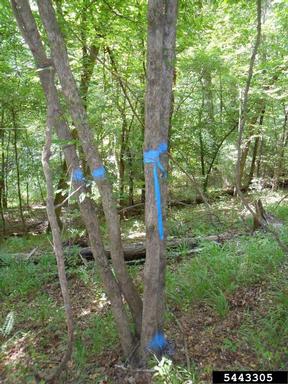
by Rick O'Connor | Aug 4, 2022
Author: Ian Stone – Forestry Extension Agent Walton County
Selecting a consulting forester is often a major decision for small to large private landowners engaged in forest management and enterprises. Consulting foresters provide technical forestry assistance in all aspects of forest management. These professionals can assist landowners by identifying goals and needs and then apply forestry expertise to meet these needs and goals. Consulting foresters are professionals who provide their services for a fee; much like lawyers or engineers. Consulting foresters provide multiple services with various fee structures which can be provided on an hourly, per acre, one-time, or percentage. For example, a herbicide treatment would often be on a per acre basis, while a timber sale would often be done on a percentage. A landowner should always have a consultant provide a scope of work along with the fee structure and estimate. It is advisable that a landowner consult several foresters or firms to compare services and fees before making a selection.

Streamside Management Zone (SMZ) marked prior to harvest so it is clear to the landowner and logger. This service is often performed by a consulting forester as part of timber sale preparation.
(Photo Credit: David Stevens, Bugwood.org Image# 5443305)
Consulting foresters are highly skilled professionals with extensive knowledge in many areas. Examples of required areas of knowledge are timber volume estimation and appraisal, forest management, tree planting and reforestation, prescribed fire, wildlife and habitat management, taxation, estate planning, forest treatment such as mechanical, herbicide, fertilization, and many more. Most consultants are well versed in all aspects of the forestry profession, but often have one or two areas of specialization. A landowner should discuss the services and credentials a forestry consultant or firm provides and select on that best fits their unique needs.
Many states require consulting foresters to become registered or certified through a professional certification board. Florida, however, is an exception to this which means landowners in Florida should thoroughly examine the forester’s professional credentials. Landowners should select a forester with the skills and credentials they require. The two largest professional organizations that set professional expectations for foresters are the Society of American Foresters (SAF) and the Association of Consulting Foresters (ACF) Examples of what to look for in credentialing are as follows:
- A 4-year bachelor’s degree in forestry or a related field; especially form an SAF accredited university forestry program
- Registration or certification in another state or nationally through the SAF Certified Forester
program
- Membership in professional forestry organizations such as ACF or SAF, along with similar
organizations such as Tree Farm, Florida Forestry Association, or Forest Landowners Association
- The ability to clearly communicate with the client and others. Ask for samples of contracts, a
written quote, an in-person meeting, and references from other landowners
- Professional integrity, honesty, and a commitment to ethical practice
Landowners can find listings of Consulting Foresters and firms in their area through multiple sources.
The Florida Forest Service (FFS) maintains an online list of consulting foresters through the FFS Vendor Database (Florida Forest Service Vendor Database (fdacs.gov)).
Landowners can find lists of registered foresters through the Alabama and Georgia boards of forestry. Most consultants close to state boundaries practice in multiple states. In addition, SAF and ACF maintain online listings of consulting foresters and members at large.
Additional Helpful Websites for Locating a Consulting Forester in the Panhandle-
Association of Consulting Foresters- Home (acf-foresters.org)
Alabama Board of Registered Foresters- ASBRF (alabama.gov)
Society of American Foresters- Find a Certified Professional (eforester.org)
References
Article adapted and paraphrased from:
Demers and Long, Selecting a Consulting Forester. Publication: SS-FOR-16 University of Florida-IFAS
Extension, EDIS
Alabama Board of Registered Foresters, Website-https://www.asbrf.alabama.gov/ Last Accessed
07/22/2022
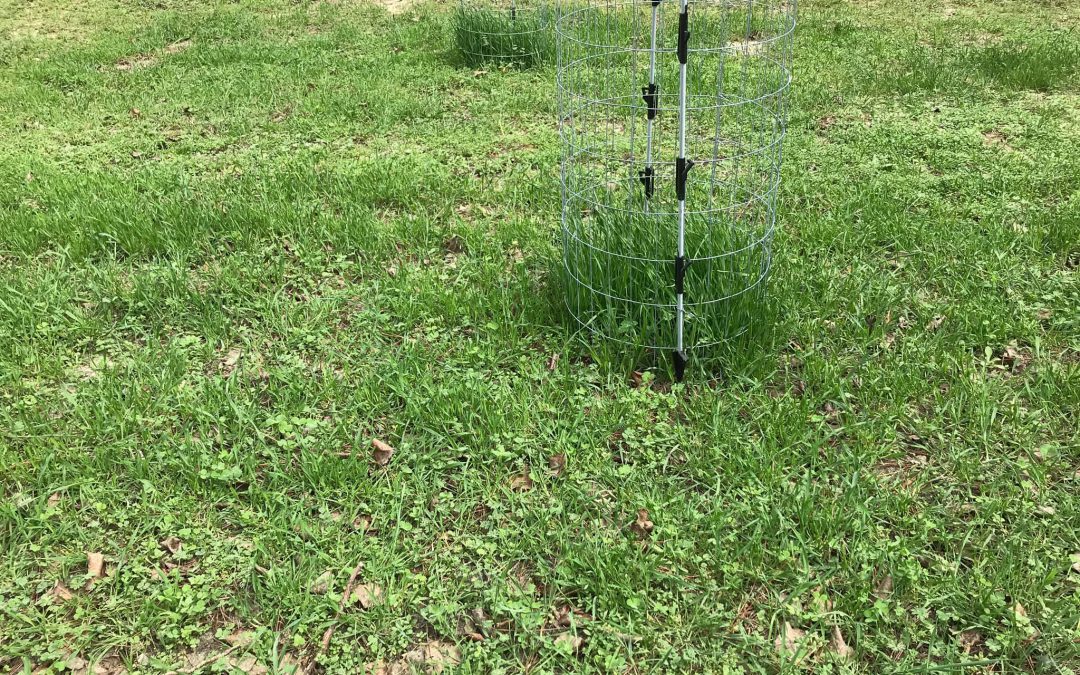
by Jennifer Bearden | Feb 3, 2022
I routinely receive calls about “failed food plots.” My normal response is to ask about soil testing first. If they performed a soil test and applied fertilizers according to the test, I move on to more questions about the planting methods. I ask what was planted, how was it planted, when was it planted. In some cases, we don’t find the problem even after all these questions. This leads me to my next question: Did you put exclusion cages on your plot?
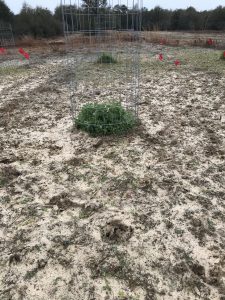
Exclusion cage in food plot with heavy deer feeding. Photo Credit: Jennifer Bearden
In my experience, I have seen wildlife feed so heavily on the food plot that you think it has failed. This can happen when you have high populations or where non-target animals feed on the plot. In one case, I saw turkeys feeding on newly sprouted plants so heavily that we had “bald spots” in the plot. In another instance, I was called to check a chufa plot that wasn’t performing well. When I arrived at the plot, there were rabbits digging up the chufas and eating them before they sprouted. In the photo here, I am showing heavy deer feeding on a demonstration plot with exclusion cages. Without exclusion cages, I would have assumed a crop failure.
Exclusion cages are simple structures that allow you to see what is growing in the plot versus what the wildlife are eating. They are easy to create and put in place. I use field fence with small openings. I use a piece that is about 5-6 foot long by 3-4 foot high. I roll the fence and make it into a circle that is about 18 inches in diameter. Then, I secure the cage in the plot with landscape staples or rods/posts. I normally install these directly after planting and fertilizing the plot.
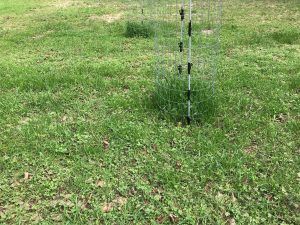
Exclusion Cage in food plot with more normal deer feeding. Photo Credit: Jennifer Bearden
Exclusion cages are just another tool to use in evaluating food plot success. These simple tools allow us to see what is growing and compare that to what the wildlife are eating. This allows us to evaluate the food plot. I would also recommend using visual observation. Look for wildlife sign in the food plot. What tracks do you see? Do you see evidence of feeding on the forages? Game cameras are also helpful in determining what wildlife are feeding on the plot. Use your tools wisely to evaluate food plot success each season and adjust accordingly.
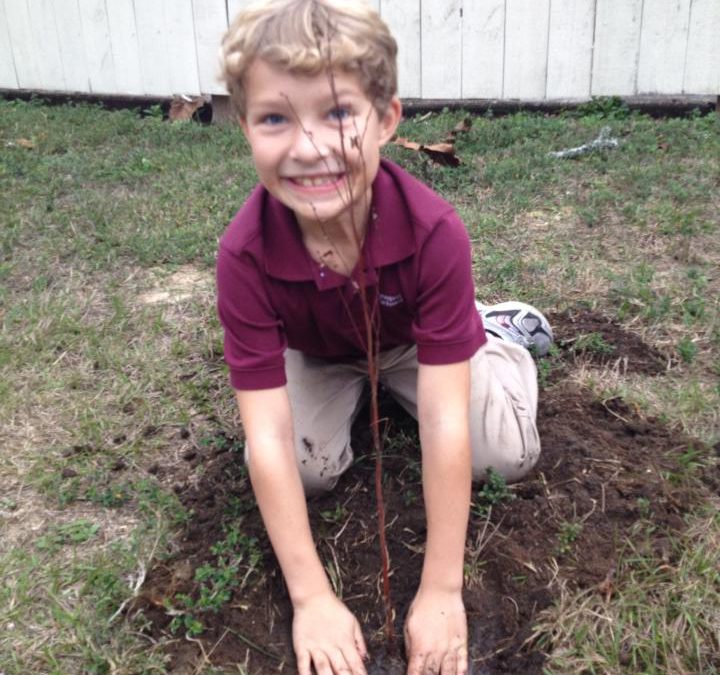
by Carrie Stevenson | Jan 20, 2022
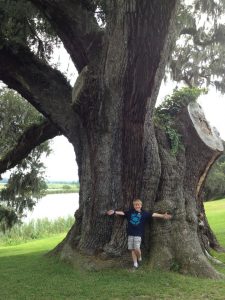
This giant heritage live oak tree has been providing oxygen, habitat, and shelter for 900 years! Photo credit: Carrie Stevenson, UF IFAS Extension
While many people think of planting trees in the spring, autumn and winter are ideal for these activities in Florida. The cooler weather means most trees are no longer actively growing and producing new leaves and fruit, so there are fewer demands on a newly planted tree to start “working” right away. The dormant winter season allows the trees to acclimate to their new environment and begin developing sturdy root systems.
However, a newly planted tree is only as valuable as the care it’s given when planted. To ensure a successful tree, important steps to follow include proper placement, planting depth, mulching, and watering.
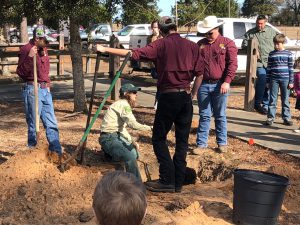
Proper tree planting practices can ensure a long-lived, healthy tree in the environment. Photo credit: Carrie Stevenson, UF IFAS Extension
Before digging, look up and around to make sure there are no overhead or underground obstacles within the reaches of the tree’s mature height or root system. When digging the planting hole, make sure the hole is 2-3 times as wide as the root ball. When planted, the topmost root flare (where the roots join the trunk) should be just above the surface of the adjacent landscape. It is not necessary to fertilize a newly planted tree. Use mulch to retain moisture in the soil, but do not place it against the tree’s trunk. Finally, water the tree daily, saturating the root ball, for 1-2 weeks then weekly for a year.
For more information on planting trees and good varieties of trees for Florida, visit this excellent resource from UF. As always, one should strive to plant the right tree in the right place. For those who live in suburban or urban areas, considerations like tree size, leaf shed, and water requirements are big concerns. For more information on size evaluation and plant selection, please visit this link from the UF Horticulture department.
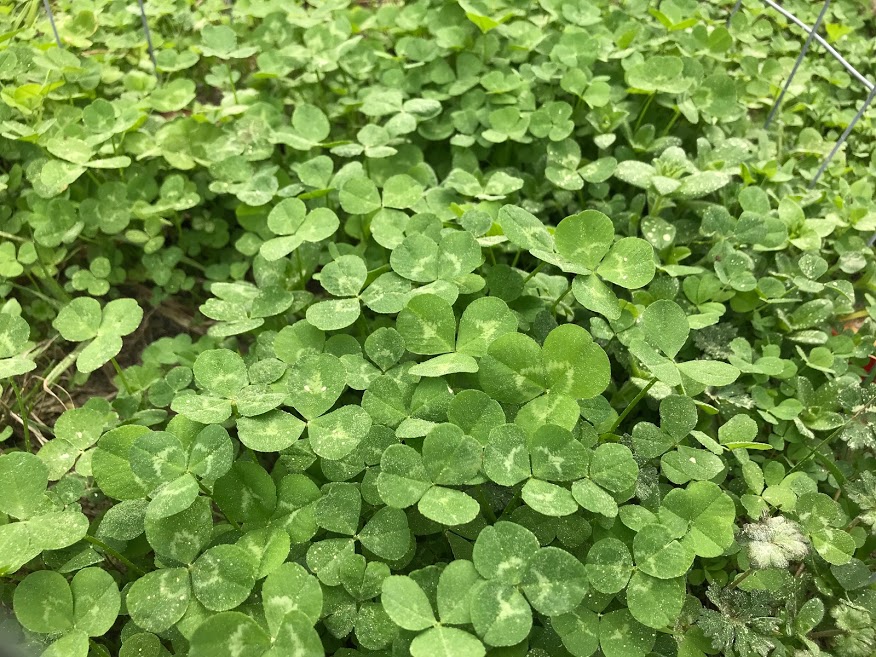
by Jennifer Bearden | Jul 15, 2021
I don’t know about you but I’m getting excited about planting cool season food plots! Now is the time to get those soil samples tested and start planning for this upcoming hunting season. Once we get our soil pH adjusted and our forages chosen, we need to turn our attention to weed management. There’s nothing more disappointing than growing weeds instead of what we planted.
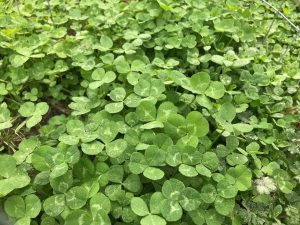
Clover Food Plot
Photo credit: Jennifer Bearden
A simple strategy is to start with a burn down treatment with a non-selective herbicide such as glyphosate. This is a safe and effective way to kill most everything growing in the food plot area. We want to apply the burn down treatment 2-4 weeks prior to planting. This will allow sufficient time for the herbicide to move into the plants and kill them.
Next step is preparing the seedbed. If the site is very weed infested, you may switch up these first two steps. Till first and wait a few weeks for new plants to emerge, then burn down weeds that emerge with a non-selective herbicide. Either way, we want a clean seedbed to plant into.
Next comes planting our desired forages. Remember that weed control becomes more difficult when we mix broadleaf plants with grasses. It’s not impossible however. Planting rate has a lot to do with weed control. If our planting rate is too low, we allow spaces for weeds to establish. Plant forages using the upper end of the seeding rate to help control weeds.
Follow up weed control options will depend on the planted forages, weeds growing and forage growth stage. We can use strategies such as mowing, selective herbicides and weed wiping with non-selective herbicides. When planting just clovers, you can refer to the following publication for chemical control options, https://edis.ifas.ufl.edu/publication/wg214. When planting small grains, 2,4-D and dicamba are good options for broadleaf weeds. These need to be applied when small grains have fully tillered but have not jointed. We get better weed control when we apply herbicides to younger weeds. Weed wiping is a great option when weeds are taller than the desired forage. Here’s a good publication on weed wiper technology and use – https://www.noble.org/globalassets/docs/ag/pubs/soils/nf-so-11-06.pdf.
For help identifying weeds and control strategies, contact your local county extension office.
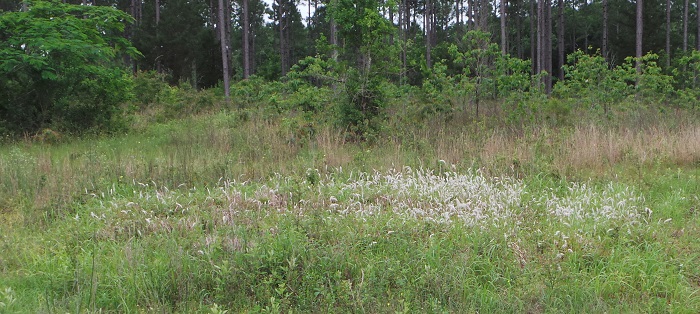
by Jennifer Bearden | Mar 26, 2021
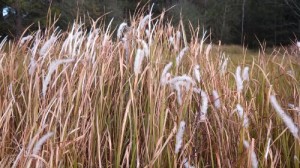
Cogongrass flowering
We’re waging war on an invasive weed, Cogongrass. Cogongrass was accidently brought into Mobile, Alabama in the early 1900’s as packing material. It was later planted in Florida and other states as a potential forage and soil stabilizer. It has low forage value and is on the Federal Noxious Weed List.
This weed can spread through both creeping rhizomes and seeds. It quickly displaces desirable grasses and plants. The roots of Cogongrass may produce allelopathic chemicals helping it out-compete other plants for space. It is drought and shade tolerant. A single plant can produce 3,000 seeds. Cogongrass is yellow/green in color with an off-set midrib and a fluffy white seed head and it grows in circular colonies.
Mowing and burning will not eradicate Cogongrass instead doing so while the plants are flowering can cause spread of seeds. Herbicide options are non-selective and kill most native ground cover such as grasses. Ridding an area of a Cogongrass infestation requires intensive management. For small infestations (less than 20-30 feet in diameter), treat the area with glyphosate once in the fall and once in the spring for 3 years (or until eradicated). For larger infestations, a more integrated approach may be necessary. Deep tilling of the soil may help in some cases.
Cogongrass is not easy to control. It takes a coordinated effort from government agencies and private landowners to work together to rid an area of this invasive weed. For more information, you can go to https://edis.ifas.ufl.edu/wg202 or contact your local extension agent.
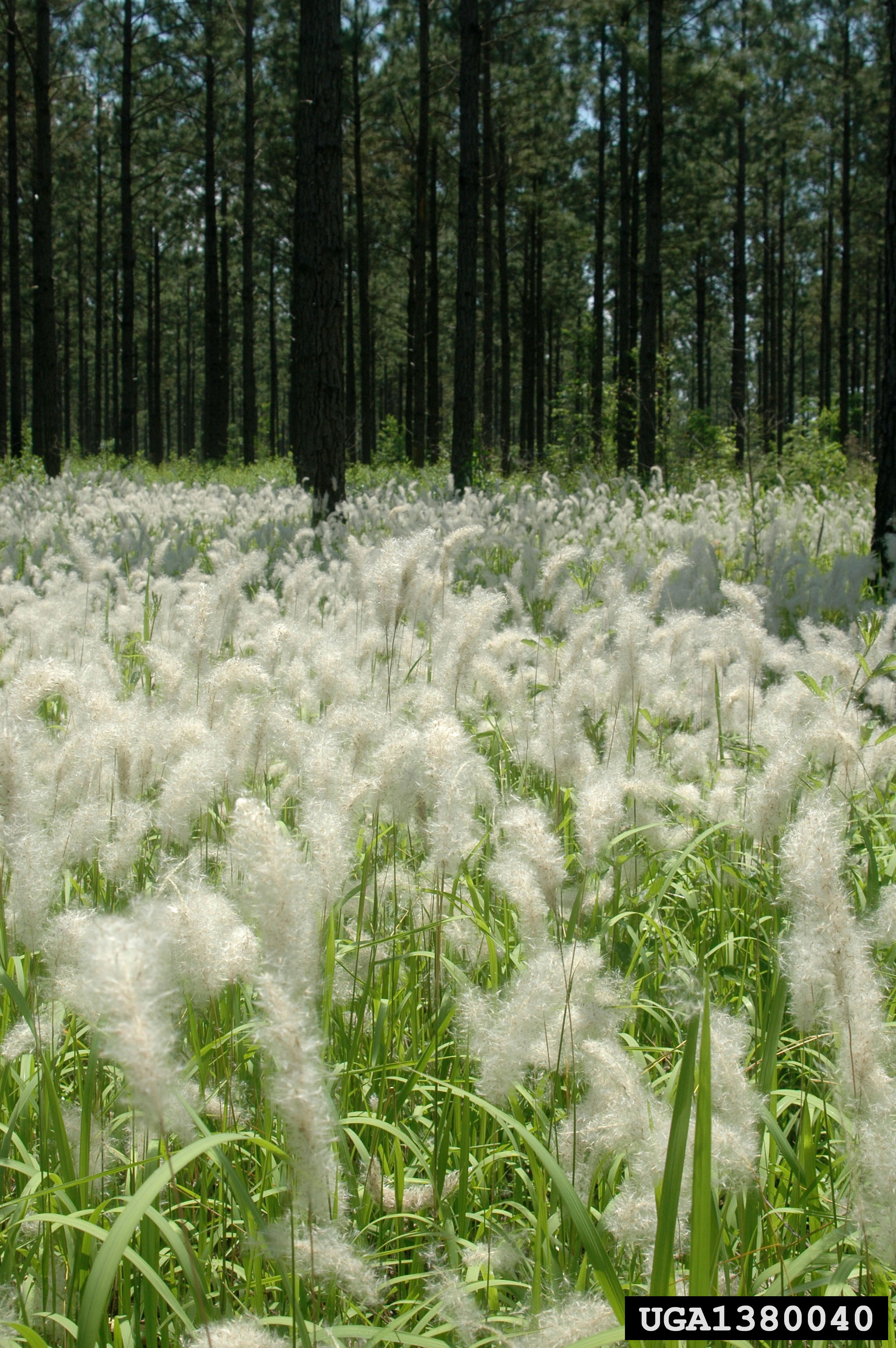
by Rick O'Connor | Mar 26, 2021
Six Rivers “Dirty Dozen” Invasive Species
Cogongrass (Imperata cylindrica)

A relatively new patch of cogongrass recently found in Washington County.
Photo Credit: Mark Mauldin
Define Invasive Species: must have all of the following –
- Is non-native to the area, in our case northwest Florida
- Introduced by humans, whether intentional or accidental
- Causing either an environmental or economic problem, possibly both
Define “Dirty Dozen” Species:
These are species that are well established within the CISMA and are considered, by members of the CISMA, to be one of the top 12 worst problems in our area.
Native Range:
Cogongrass is from southeast Asia.
Introduction:
It was accidentally introduced as an “escapee” from satsuma crates brought to Grand Bay, Alabama in 1912. It was later intentionally introduced into Mississippi in the 1920s as a forage crop and then to Florida in the 1930s for both forage and soil stabilization.
EDDMapS currently list 79,134 records of this plant. All are listed in the southeastern U.S. Most are in Florida and Alabama, but there are records from Mississippi, Louisiana, Texas, Georgia, North and South Carolina.
Within our CISMA there are 13,279 records. This is probably underreported.
Description:
Cogongrass is a perennial grass that can vary in color from a bright-light green when young to a brown-orange when older. It does die back in areas with cold winters and heavy frost and becomes brown. The leaves emerge from the ground in clumps and can reach four feet in height. The blades are 0.5-0.75 inches wide and the light-colored midline is off center. The blades are serrated along the edge. In the spring the grass produces large white colored fluffs of seeds extending above the leaves to be carried by the wind. There are numerous small seeds joined on long hairs of these structures. There is an extensive rhizome system beneath the ground that can contribute to short distance spread.
Issues and Impacts:
The plant spreads aggressively and has been found in ditches, along roadsides, in pastures, timberlands, golf courses, empty lots, and even on barrier islands. It spreads both by seed wind dispersal and rhizome fragmentation. The plant is known to be allelopathic, desiccating neighboring plants and moving in. It can form dense monocultures in many areas.
The serrated edges of the leaves make it undesirable as a livestock forage, a fact not detected until the plant was established. It can cover large areas of pasture making it unusable. In the winter the plant becomes brown and can burn very hot. Timberland that has been infested with cogongrass can burn too hot during prescribed burns actually killing the trees.
It is currently listed as one of the most invasive plants in the United States. It is a federal and state noxious weed, it is prohibited all across Florida and has a high invasion risk.
Management:
The key to controlling this plant is destroying the extensive rhizome system. Simple disking has been shown to be effective if you dig during the dry season, when the rhizomes can dry out, and if you disk deep enough to get all of the rhizomes. Though the rhizomes can be found as deep as four feet, most are within six inches and at least a six-inch disking is recommended.
Chemical treatments have had some success. Prometon (Pramitol), tebuthurion (Spike), and imazapyr have all had some success along roadsides and in ditches. However, the strength of these chemicals will impede new growth, or plantings of new plants, for up to six months. This can lead to erosion issues that are undesirable. Glyphosate has been somewhat successful, and its short soil life will allow the planting of new plants immediately. Due to this however, it may take multiple treatments over multiple years to keep cogongrass under control and it will kill other plants if sprayed during treatment.
Most recommend a mixture of burning, disking, and chemical treatment. Disking and burning should be conducted in the summer to remove thatch and all older and dead cogongrass. As new shoots emerge in late summer and early fall herbicides can then be used to kill the young plants. Studies and practice have found complete eradication is difficult. It is also recommended not to attempt any management while in seed (in spring). Tractors, mowers, etc. can collect the seeds and, when the mowers are moved to new locations, spread the problem. If all mowing/disking equipment can be cleaned after treatment – this is highly recommended.
For more information on this Dirty Dozen species, contact your local extension office.
References
Cogongrass, University of Florida IFAS Center for Aquatic and Invasive Plants
https://plants-archive.ifas.ufl.edu/plant-directory/imperata-cylindrica/
Imperata cylindrica. University of Florida IFAS Assessment.
https://assessment.ifas.ufl.edu/assessments/imperata-cylindrica/.
Early Detection and Distribution Mapping System (EDDMapS)
https://www.eddmaps.org/
Six Rivers CISMA
https://www.floridainvasives.org/sixrivers/













